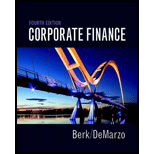
a)
To determine: The net income for 2006.
Introduction:
The net income is a company’s total profit; it is calculated by talking revenues and deducting the cost of doing business like taxes,
a)
Answer to Problem 1P
The net income for 2006 is $120 million.
Explanation of Solution
Given information:
P Pharmaceuticals has EBIT of $325 million in 2006; it has interest expenses of $125million and tax of 40%.
Formula to compute net income:
Where,
EBIT (Earnings Before Interest and Taxes).
Compute the net income:
Hence, the net income for 2006 is $120 million.
b)
To determine: The net income for 2006.
Introduction:
The net income is a company’s total profit; it is calculated by talking revenues and deducting the cost of doing business like taxes, depreciation interest and other expenses. Net income measures the profitability of the company over a period of time.
b)
Answer to Problem 1P
The total net income for 2006 is $245 million.
Explanation of Solution
Given information:
P Pharmaceuticals has EBIT of $325 million in 2006;it has interest expenses of $125 million and tax of 40%.
Formula to compute total net income:
Compute the total net income:
Hence, the total net income for 2006 is $245 million.
c)
To determine: The net income when there is no interest expenses in 2006 and to compare with the total net income.
Introduction:
The net income is a company’s total profit; it is calculated by talking revenues and deducting the cost of doing business like taxes, depreciation interest and other expenses. Net income measures the profitability of the company over a period of time.
c)
Answer to Problem 1P
The total net income for 2006 is $245 million.
Explanation of Solution
Given information:
P Pharmaceuticals has EBIT of $325 million in 2006, and corporate tax of 40%.
Formula to compute net income without interest expenses:
Compute the total net income without interest expenses:
Hence, the net income without interest expense for the year 2006 is $195 million.
Formula to compare total net income without interest expenses:
Compute the total net income without interest expenses:
Hence, the total net income is higher with $50million than the net income without expenses.
d)
To determine: The interest tax shield in 2006.
Introduction:
An interest tax shield is a deduction in taxable income for a corporation or an individual achieved through claiming deduction like depreciation, charitable donations and, mortgage interest. Tax shield lowers the overall cost of taxes owned by the individual taxpayer.
d)
Answer to Problem 1P
The interest tax shield for 2006 is $50 million.
Explanation of Solution
Given information:
P Pharmaceuticals has EBIT of $325 million in 2006, has interest expenses of $125million and tax of 40%.
Formula to compute interest tax shield:
Compute the interest tax shield:
Hence, the interest tax shield for the year 2006 is $50 million.
Want to see more full solutions like this?
Chapter 15 Solutions
Corporate Finance (4th Edition) (Pearson Series in Finance) - Standalone book
- Crenshaw, Incorporated, is considering the purchase of a $367,000 computer with an economic life of five years. The computer will be fully depreciated over five years using the straight-line method. The market value of the computer will be $67,000 in five years. The computer will replace five office employees whose combined annual salaries are $112,000. The machine will also immediately lower the firm's required net working capital by $87,000. This amount of net working capital will need to be replaced once the machine is sold. The corporate tax rate is 22 percent. The appropriate discount rate is 15 percent. Calculate the NPV of this project. Note: Do not round intermediate calculations and round your answer to 2 decimal places, e.g., 32.16. NPV Answer is complete but not entirely correct. S 103,141.80arrow_forwardYour firm is contemplating the purchase of a new $610,000 computer-based order entry system. The system will be depreciated straight-line to zero over its five-year life. It will be worth $66,000 at the end of that time. You will save $240,000 before taxes per year in order processing costs, and you will be able to reduce working capital by $81,000 (this is a one-time reduction). If the tax rate is 21 percent, what is the IRR for this project? Note: Do not round intermediate calculations and enter your answer as a percent rounded to 2 decimal places, e.g., 32.16. IRR %arrow_forwardQUESTION 1 Examine the information provided below and answer the following question. (10 MARKS) The hockey stick model of start-up financing, illustrated by the diagram below, has received a lot of attention in the entrepreneurial finance literature (Cumming & Johan, 2013; Kaplan & Strömberg, 2014; Gompers & Lerner, 2020). The model is often used to describe the typical funding and growth trajectory of many startups. The model emphasizes three main stages, each of which reflects a different phase of growth, risk, and funding expectations. Entrepreneur, 3 F's Debt(banks & microfinance) Research Business angels/Angel Venture funds/Venture capitalists Merger, Acquisition Grants investors PO Public market Growth (revenue) Break even point Pide 1st round Expansion 2nd round 3rd round Research commercial idea Pre-seed Initial concept Seed Early Expansion Financial stage Late IPO Inception and prototype Figure 1. The hockey stick model of start-up financing (Lasrado & Lugmayr, 2013) REQUIRED:…arrow_forward
- critically discuss the hockey stick model of a start-up financing. In your response, explain the model and discibe its three main stages, highlighting the key characteristics of each stage in terms of growth, risk, and funding expectations.arrow_forwardSolve this problem please .arrow_forwardSolve this finance question.arrow_forward
 Intermediate Financial Management (MindTap Course...FinanceISBN:9781337395083Author:Eugene F. Brigham, Phillip R. DavesPublisher:Cengage Learning
Intermediate Financial Management (MindTap Course...FinanceISBN:9781337395083Author:Eugene F. Brigham, Phillip R. DavesPublisher:Cengage Learning

